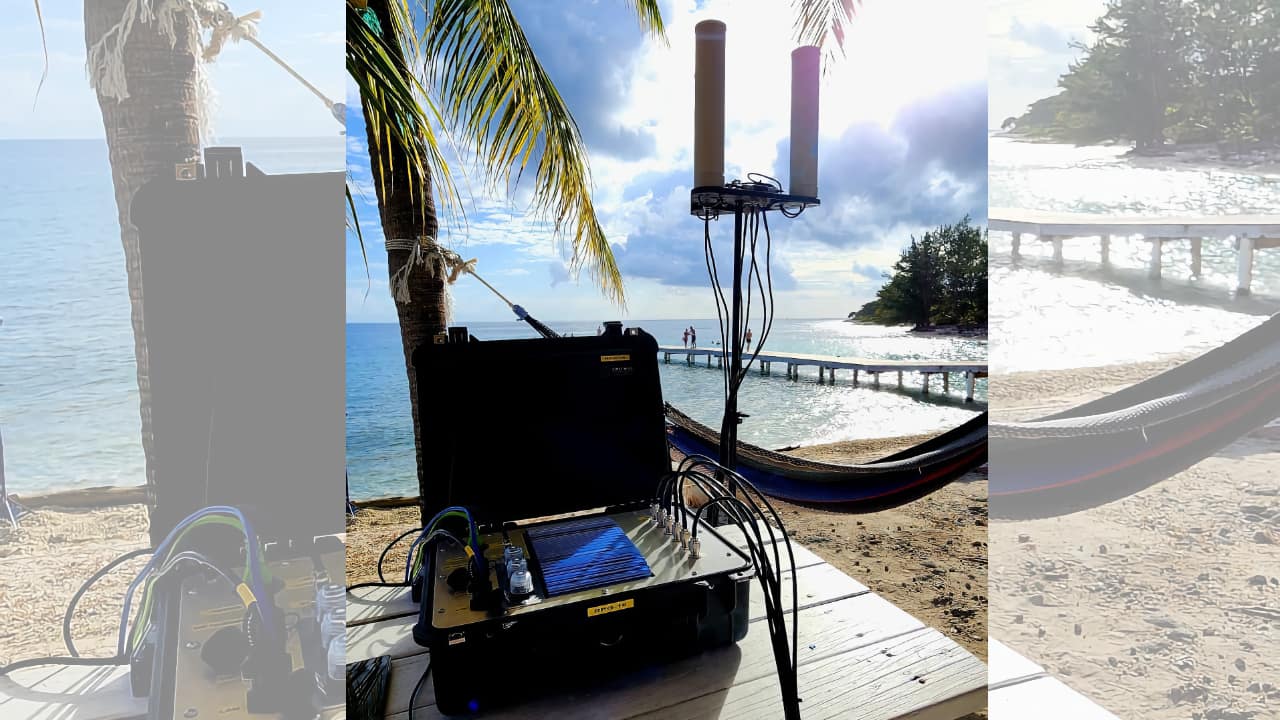
How do you connect to the cloud when you’re not near a fixed network connection? First Mile is an interesting new option to bridge that gap.
For all its ubiquity, the cloud can be tricky to connect with. Any internet connection is, by definition, connected to the cloud, but not all connections are equal to the task of handling video content - especially the high bitrate flavours associated with video production.
For fixed-location production, most buildings in most cities have perfectly adequate - and sometimes very fast - internet connections. But the further you get from population centres, the harder it gets to find a suitable pipeline to the cloud. You might also want to use an entirely separate network for security and performance issues.
It’s easy to be lulled into a false sense of available connectivity by smartphones, but these are subject not only to the laws of physics but also to the operational and commercial priorities of mobile networks.
You might have noticed that, sometimes, your mobile signal can come and go, even if you’re not moving. That shouldn’t happen, but one reason it might is that networks have a fixed capacity. At busy times, if more people are trying to connect than the network has capacity for, it will - counter-intuitively - *reduce* the power of its transmitter until it is only in contact with the number of phones it can cope with. For everyone else, it’s tough, mainly because these outages are entirely unpredictable. It can happen when there’s a traffic accident on a major road, causing everyone to phone ahead to say they will be late.
Networks can be strong in some areas and weak in others. Sometimes, you’ll find that your phone works well in a location, but the data SIM you’re using to access cloud services is connected to a network without coverage.
The need for more
If your production workflow depends on cloud services, then you need more than this. Combining mobile networks and LEO (Low Earth Orbit) satellites can help, but no single mobile service can provide the sort of reliability you need if high bandwidth mobile connectivity is on your critical path. Nor can it match the security of a purposely designed network that always operates within a VPN tunnel.
If you’re not already using cloud workflows, let’s look at why you might want to. While early camera-to-cloud demonstrations were little more than a proof of concept, cloud workflows have now reached a level of proficiency where they are a viable option for any level of video production, and the advantages are enormous. The cloud is geographically agnostic. It’s everywhere, subject only to a decent and reliable connection. It enables remote and collaborative working. You can set up teams across the globe (or across the street) and share media with them at any time.
With camera to cloud you can go from acquisition to publishing on social media - or even a news channel - within minutes. Atomos calls this “From Lens to Likes”, with good reason: if you can get your material published first, you’ll get the majority of the traffic. You’ll get attention, engagement, and all the benefits of revenue that is proportional to views.
But there is still the question of how you connect to the cloud when even the fast mobile networks are designed for short, bursty, transactional data and not large, long media files. This is the problem that First Mile is designed to solve with scalable options for a wide range of operating scenarios. The company’s mobile data products use professionally configured SIM cards, dedicated hardware and technical measures to ensure constant, high-bandwidth connectivity.
Blending connectivity
An example of how First Mile works in a variety of workflows. Click for larger image
The easiest to understand is blending. Unless you’re in a cave or a lead-lined room, you’ll probably get some kind of mobile signal. You might also be in the WiFi range, but the signal’s unreliable. Blending can spread the data load - and the risk - across multiple, diverse networks. To users, blending is transparent - it just feels like a fast, reliable connection. What’s happening under the hood is that software running on your comms device analyses the current state of multiple networks and allocates your data across them to smooth out differences in data rates and to give a net increase in the available bandwidth - and reliability.
With 5G, which is an entire family of technologies unified around the goal of improving bandwidth and latency, with the appropriate mobile network account - not usually available to consumers - it’s called “network slicing”, and it makes it possible to reserve a fixed portion of the network bandwidth for you and your team. It means that there will never be contention between multiple users as they can’t encroach on your reserved patch of the data connection.
Beyond this, there are dozens of “tricks of the trade” and “qualified users only” tweaks and setups that are only available to companies with a deep level of competence in network configuration.
Frame.io is driving the industry towards a camera-to-cloud workflow, with companies like Atomos, Teradek and Sound Devices releasing hardware and software products that specifically embrace the cloud. Real-time cloud storage company LucidLink is among those underpinning remote, collaborative editing, bringing the prospect of cloud-only workflows closer to every filmmaker.
But if you have no fixed WiFi or physical network connection - usually the case if you’re away from home or on location - then First Mile Technologies can make an incredible difference to your ability to use super-productive cloud production workflows. You can start *editing* while shooting, work collaboratively with your teams - wherever they are, and even deliver your edited content directly to social media or even a newsroom.
Check out First Mile Technologies at https://firstmile.tech/
Tags: Production



Comments